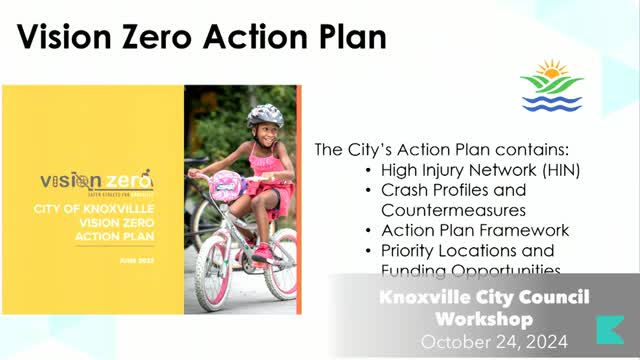Knoxville aims for zero traffic fatalities with new strategies
October 28, 2024 | City Council Workshop Meetings, Knoxville City, Knox County, Tennessee
This article was created by AI summarizing key points discussed. AI makes mistakes, so for full details and context, please refer to the video of the full meeting. Please report any errors so we can fix them. Report an error »

In a recent government meeting, officials discussed the alarming rise in traffic fatalities in Knoxville, revealing that 2023 saw a significant increase in roadway deaths, with 36 fatalities reported—up from the typical low to mid-20s. This spike has prompted a renewed focus on the Vision Zero initiative, which aims to eliminate traffic deaths and serious injuries.
The meeting highlighted a detailed analysis of crash data, identifying a \"high injury network\" where 5% of non-interstate roadways accounted for 63% of life-altering crashes. Key contributors to these incidents include impaired driving, speeding, and a lack of seatbelt use, with 97% of fatal crashes occurring on roads with speed limits over 25 miles per hour. Officials emphasized that 60% of fatalities involved drugs or alcohol, and 44% involved unrestrained occupants.
To combat these issues, the city has developed an action plan that includes 30 strategies, one of which is the hiring of a full-time Vision Zero coordinator. The plan prioritizes safety measures on major arterials, such as Chapman Highway and Kingston Pike, which are critical to addressing the most severe crash profiles.
Despite the grim statistics, officials expressed optimism about the potential for change, citing successful examples from other U.S. cities like Hoboken, New Jersey, which has gone seven years without a traffic fatality. They stressed that achieving zero fatalities is not just aspirational but attainable through a paradigm shift in traffic safety approaches.
The meeting concluded with a commitment to reevaluate how traffic safety is perceived, moving away from viewing crashes as inevitable accidents to recognizing them as preventable incidents. This shift includes a focus on systemic changes that prioritize the safety of all roadway users, including pedestrians and cyclists, and a commitment to learning from past incidents to improve future safety measures.
The meeting highlighted a detailed analysis of crash data, identifying a \"high injury network\" where 5% of non-interstate roadways accounted for 63% of life-altering crashes. Key contributors to these incidents include impaired driving, speeding, and a lack of seatbelt use, with 97% of fatal crashes occurring on roads with speed limits over 25 miles per hour. Officials emphasized that 60% of fatalities involved drugs or alcohol, and 44% involved unrestrained occupants.
To combat these issues, the city has developed an action plan that includes 30 strategies, one of which is the hiring of a full-time Vision Zero coordinator. The plan prioritizes safety measures on major arterials, such as Chapman Highway and Kingston Pike, which are critical to addressing the most severe crash profiles.
Despite the grim statistics, officials expressed optimism about the potential for change, citing successful examples from other U.S. cities like Hoboken, New Jersey, which has gone seven years without a traffic fatality. They stressed that achieving zero fatalities is not just aspirational but attainable through a paradigm shift in traffic safety approaches.
The meeting concluded with a commitment to reevaluate how traffic safety is perceived, moving away from viewing crashes as inevitable accidents to recognizing them as preventable incidents. This shift includes a focus on systemic changes that prioritize the safety of all roadway users, including pedestrians and cyclists, and a commitment to learning from past incidents to improve future safety measures.
View full meeting
This article is based on a recent meeting—watch the full video and explore the complete transcript for deeper insights into the discussion.
View full meeting
